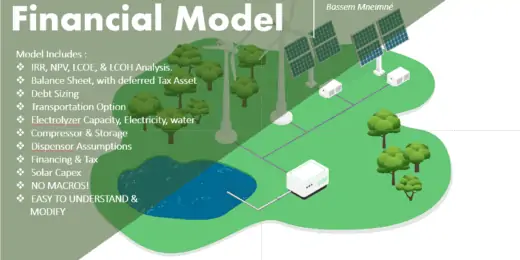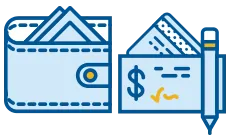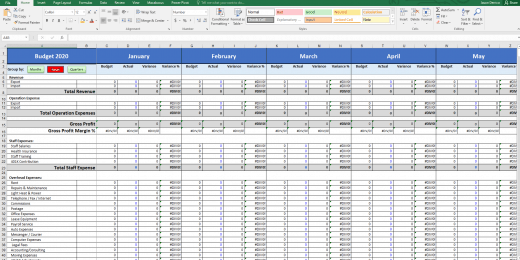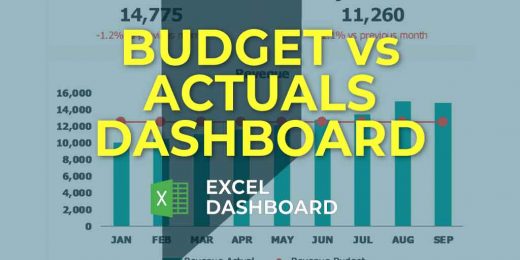Achieving Mastery in Budget Actual Variance Analysis Template: The Definitive Guide

Achieving mastery in budget actual variance analysis requires a comprehensive guide and a structured template. As financial accuracy becomes critical, a definitive guide ensures precise budget management.
Mastering budget actual variance analysis is crucial for businesses to maintain financial health and make informed decisions. A solid understanding of where and why actual spending deviates from the budget can highlight inefficiencies and areas requiring improvement. This guide serves as an indispensable tool for finance professionals and accountants who aim to improve their fiscal strategies and control mechanisms.
Equipped with an effective template, users can systematically track financial performance, identify trends, and implement corrective actions quickly. The key is to leverage accurate data analysis and utilize a template that simplifies the complexity of financial tracking. Understanding the nuances of each variance fosters a culture of accountability and strategic planning within an organization, making this guide the cornerstone of effective budget management.
Introduction To Budget Variance Analysis
Budget Variance Analysis is a beacon in the stormy seas of financial planning.
It lets businesses know if they are on the golden path of success or meandering off track.
Understanding this concept equips you with the power to steer your company’s budget towards your goals.
Importance In Financial Planning
In the intricate dance of numbers, knowing where every penny goes is crucial.
The art of Budget Variance Analysis shines a light on differences between expected and actual financial performance.
This insight becomes the bedrock for wise financial decision-making.
- Control Spending: It spots where money slips through the cracks.
- Boost Profits: It uncovers opportunities to save or reallocate funds.
- Target Achievements: It ensures goals align with financial reality.
Basic Concepts And Terminology
To master Budget Variance Analysis, start by wrapping your brain around some key terms:
| Term | Definition |
|---|---|
| Budget | Plan showing how to spend money over a period. |
| Actual | Real figures representing money actually spent or made. |
| Variance | Difference between budgeted and actual amounts. |
Get friendly with these terms, as they’re the puzzle pieces of any reliable financial strategy.
Key Components Of A Budget Actual Variance Template
The key to mastering Budget Actual Variance Analysis lies in creating a detailed template. Such a template empowers businesses to track budgets, actual expenses, and variances effectively. Here, discover the essential components needed to build a template that not only simplifies analysis but ensures financial control.
Column Structure And Design
A well-structured column design is the backbone of a functional template. Start with these key columns for clarity:
- Category: The type of expense or income.
- Budgeted Amount: What you plan to spend or receive.
- Actual Amount: The real figures after execution.
- Variance: The difference between budgeted and actual amounts.
- Percentage Variance: A quick view of the variance in percentage form.
- Comments: Notes on why variances occurred.
Ensure your columns are clearly labeled and color-coded to reduce errors and enhance readability.
Critical Data Points To Include
Including essential data points leads to insightful analysis. Your template must account for:
| Data Point | Description | Importance |
|---|---|---|
| Time Period | The period for which the budget applies. | Allows for time-based analysis. |
| Forecasted Revenue | Projected earnings for the period. | Compares expected and actual performance. |
| Operational Costs | Everyday business expenses. | Helps in tracking efficiency. |
| Capital Expenditure | Investments in assets or improvements. | Useful for long-term financial strategy. |
| Cash Flow | Liquidity entering and leaving the business. | Essential for managing solvency. |
Remember to keep each data point specific, measurable, and tailored to your business needs for a thorough variance analysis.
Setting Up Your Template: A Step-by-step Guide
Mastering Budget Actual Variance Analysis boosts your financial expertise. Your first step? A stellar template. This guide simplifies every step.
Selecting The Right Software
Pick software that fits like a glove. It should crunch numbers and visualize data effortlessly. Consider these factors:
- User friendliness: Is it easy to navigate?
- Features: Look for custom reports and auto-calculation.
- Integration: It should play nice with other systems.
- Cost: High price doesn’t always mean high quality.
- Support: Good help makes a good product great.
Excel and Google Sheets are popular. Others prefer specialized accounting software. Choose what works for you.
Laying The Foundation With Initial Data
Gather all your data. This sets your template on solid ground. Here’s how to start:
- Historical data: Past budgets and expenses give insight.
- Income sources: Know where the cash flows from.
- Fixed costs: Rent and salaries stay mostly the same.
- Variable costs: These change with business activity.
Populate your template. Here’s a basic table structure:
Add more categories as needed
| Category | Budgeted Amount | Actual Amount | Variance |
|---|---|---|---|
| Income | $XX,XXX | $XX,XXX | $XXX |
| Expenses | $XX,XXX | $XX,XXX | $(XXX) |
Stay tuned to refine your template further. Mastery is within reach!
Categorizing Expenses And Revenues
Mastering budget actual variance analysis begins with the basics: categorizing expenses and revenues. This process creates a clear financial picture. It helps in understanding where every dollar goes and comes from. Sorting costs and incomes correctly sets the stage for detailed variance analysis. A deeper understanding leads to better financial decisions.
Fixed Vs. Variable Costs
Knowing the nature of costs is vital. It determines how they respond to changes in business activity levels. Let’s break them down.
- Fixed costs: Costs that don’t change with production levels. Examples include rent, insurance, and salaries.
- Variable costs: Costs that vary with production output. Examples are raw materials and sales commissions.
| Cost Type | Characteristics | Examples |
|---|---|---|
| Fixed Costs | Stable, predictable, unchanging with levels of output. | Rent, insurance. |
| Variable Costs | Fluctuate with production or sales volume. | Raw materials, sales commissions. |
Understanding these costs leads to better budgeting. It also impacts your company’s profitability analysis.
Income Streams Identification
Just as with costs, knowing where your money comes from is crucial. There are various income streams.
- Primary Income: Revenue from the main business activities.
- Secondary Income: Comes from side activities or investments.
Identifying these ensures accurate tracking of financial performance. Use categorization to forecast and plan for future growth. It also helps in recognizing the most profitable segments.
Calculating Variances: Formulas And Functions
Mastering budget analysis is like unlocking a secret level in a game. It can make or break financial success. The Calculating Variances: Formulas and Functions section dives into how to spot differences between what was expected and what actually happened. Let’s explore the math magic behind it.
Variance Percentage Calculations
Knowing how much things have changed is super important. We use special math to figure this out.
Look at this simple formula:
Percentage Variance = ((Actual - Budget) / Budget) 100
Let’s say your lemonade stand earned $150. But you wanted to make $200. Here’s the math:
- Budget (Plan): $200
- Actual (Reality): $150
- Variance: $150 – $200 = -$50
- Percentage Variance: (-$50 / $200) 100 = -25%
This means you earned 25% less than you thought!
Absolute Value Vs. Relative Value Analysis
Absolute value is like counting actual marshmallows in your hot chocolate. Relative value is like deciding if it’s enough compared to yesterday’s cup.
To compare well, consider both. Absolute tells us the size of the change. Relative tells us the size compared to the plan.
| Absolute Value | Relative Value | |
|---|---|---|
| Formula | |Actual – Budget| | (Actual – Budget) / Budget |
| Lemonade Stand | |$150 – $200| = $50 | ($150 – $200) / $200 = -0.25 |
In our lemonade example, absolute tells us we made $50 less. But relative tells us it’s 25% less than our goal.
Using both helps us understand our lemonade business better.
Analyzing Budget Variances
In the world of finance, analyzing budget variances is like detective work. It involves examining financial statements to find clues about a company’s performance. A strong grasp on where and why budget variances occur equips managers to steer their companies to success. Let’s delve into the critical steps of mastering variance analysis through a Budget Actual Variance Analysis Template.
Identifying Significant Deviations
Finding significant deviations helps managers to focus on important figures. A template serves as a map, highlighting discrepancies between what was planned in the budget and what actually happened. Here’s how to spot these critical variances:
- Compare actual results with budgeted numbers line by line
- Look for large gaps that could signal issues
- Use percentage differences to weigh the impact
Additional rows as needed
| Budgeted Amount | Actual Amount | Variance | % Difference |
|---|---|---|---|
| $10,000 | $8,000 | -$2,000 | -20% |
Understanding The Why Behind The Numbers
Knowing the ‘why’ is just as crucial as detecting the ‘what.’ By understanding the factors behind the numbers, one can take corrective actions. This understanding comes from:
- Analyzing market trends and comparing them to your outcomes.
- Discussing with department heads to get insight into variances.
- Training your team to recognize indicators of variance causes.
With these steps, managers can respond to budget variances proactively. They can make informed decisions to guide their companies toward financial stability and growth.
Adjusting Your Budget: Responsive Strategies
Nailing budget management means being ready to respond when numbers don’t align. Learn to adjust swiftly with strategies that not only fix but improve your budget planning. This guide walks through both short-term and long-term adjustments.
Short-term Remedial Actions
When actual numbers drift from your budget, quick fixes prevent small issues from growing. Short-term actions keep you on track for the current cycle.
- Review Expenditures: Pinpoint where expenses exceeded predictions.
- Immediate Corrections: Reduce or halt spending in over-budget areas.
- Communicate Changes: Update teams promptly to ensure unified action.
Long-term Strategic Adjustments
Long-term changes guard against future variances. They bolster the resilience of your financial plans.
- Performance Analysis: Assess which areas repeatedly over-perform or underperform.
- Adjust Forecasts: Revise your predictions based on fresh insight and trends.
- Revise Policies: Reinforce budget protocols or design new ones to enhance control.
Reporting Financial Performance
Understanding the financial health of a business is vital. Reporting financial performance can be complex. But with a budget actual variance analysis template, it gets easier. This analysis sheds light on how well a company controls its finances by comparing budgeted figures to actuals. A well-designed template ensures clarity, accuracy, and actionable insights for decision-makers.
Visualizing Data For Stakeholders
Clear visuals are key to good reporting. They turn complex data into understandable stories. Here’s how to do it.
- Use charts to illustrate trends over time.
- Include graphs that compare budgeted versus actual figures.
- Showcase key variances with color-coding.
Create visuals that make data accessible to all stakeholders. Transform numbers into meaningful insights. Stakeholders will value visual simplicity and directness.
Crafting A Narrative Around Your Findings
Finding data variances is just the start. Telling a story with data is what matters.
- Start with the most significant variances.
- Explain why these differences occurred.
- Discuss the impact on the business.
Compose a story that guides stakeholders through your analysis. Highlight the wins and areas for improvement. This approach turns data into actionable advice.
Best Practices For Sustained Mastery
Mastering your budget actual variance analysis template is essential for precise financial control. Let’s explore the best practices to keep this mastery going strong.
Continuous Learning And Adaptation
Stay ahead of the game with constant learning. The world of finance is always shifting, so your skills should too.
- Enroll in webinars to learn new trends and tools.
- Read industry publications for insights and updates.
- Review past variance reports to spot patterns and outliers.
- Get stakeholder input to align your analysis with business goals.
Adapt your template to changes in regulations and market conditions. This ensures accuracy and reliability.
Incorporating Feedback Loops
Critique your analysis regularly. Feedback fine-tunes your mastery.
Use feedback to upgrade your template. Adjust it for better results next time.
Software tools can automate feedback collection. Use them to your advantage.
Leveraging Technology For Enhanced Analysis
Mastering the art of budget variance analysis just got easier. Today, advanced technology ensures accuracy, speed, and efficiency. Fancy spreadsheets are out; smart tools are in. They spot differences between your budgeted numbers and actuals in real-time. Look no further for a deep dive into these savvy tech solutions.
Budgeting Software Tools
The right software turns numbers into insights. It does the heavy lifting for you.
- Visual dashboards simplify complex data.
- Pre-built templates save you time.
- Collaborate with teams anywhere.
Imagine forecasting trends with a few clicks. These tools make it happen.
Automating Variance Alerts
- Set custom triggers for variances.
- Receive instant notifications.
- Stay proactive, not reactive.
With automated alerts, you’re always on top of your numbers. Take swift action when it matters most. Ready to take control? Embrace these tech trends and transform your analysis process.
Case Studies: Success Stories In Variance Analysis
Exploring real-world examples proves invaluable in understanding the power of budget actual variance analysis. Businesses of all sizes have transformed their financial health through meticulous analysis and strategic adjustments. These case studies illuminate the path to fiscal mastery and showcase strategies that could propel any organization to new heights.
Business Turnaround Tales
Every company’s dream to bounce back from the brink of financial distress hinges on smart analysis and decisive action.
| Company | Problem | Solution | Result |
|---|---|---|---|
| X Corp | Revenue dip | Cost-cutting measures | Profits soared |
| Y Inc | Excess inventory | Liquidation, realigned procurement | Streamlined operations |
With a clear-eyed view of their financial standings, these businesses tailored strategies to address specific pain points, leading to remarkable comebacks.
Innovative Budget Reallocation Strategies
Shifting resources within a budget can ignite growth and improve efficiency. Leaders who employ creative reallocation can turn underperformance into opportunity.
- Redirecting funds from underperforming projects to areas with higher ROI.
- Investing in technology to automate processes, saving costs long-term.
- Training staff to multitask, maximizing human resource potential.
This proactive approach to budget management ensures that funds are always fueling the most impactful segments of a business.
Conclusion: The Ongoing Journey Of Financial Mastery
Mastering the intricacies of financial analysis is not a one-time task, but a continuous voyage. The Budget Actual Variance Analysis Template is your compass on this endless sea. Grasping its nuances empowers analysts to plot a steady course through the tumultuous waters of finance.
Summary Of Key Takeaways
- Understanding variances secures a firm grasp on financial health.
- Implementing templates simplifies intricate financial processes.
- Regular review promotes dynamic adaptation to changes.
- Decision-making becomes sharper with accurate data.
- Communication improves through clear, visual reports.
A deep dive into Budget Actual Variance Analysis Template illuminates your financial path. The key takeaways are beacons guiding towards proficient decision-making. Armed with knowledge, analysts wield the power to affect positive change.
The Road Ahead For Financial Analysts
For aspiring maestros of finance, the journey never ends. Technological advancements will continue to reshape the landscape. Analysts must stay alert, ready to adapt and grow.
| Focus Area | Skills to Enhance |
|---|---|
| Data Analytics | Precision in Interpretation |
| Reporting Tools | Proficiency in Software |
| Continuous Learning | Adapting to Innovations |
Embrace emerging tools and refine your analytical prowess. Your role demands perpetual learning and agility. Financial analysts carve the path to corporate success, with mastery over the Budget Actual Variance Analysis Template as their guide.
Frequently Asked Questions
How Do You Calculate Master Budget Variance?
Calculate master budget variance by subtracting the budgeted figures from actual income and expenses, then analyze discrepancies.
How Do You Prepare A Budget Variance Analysis?
Start by gathering your budget and actual financial data. Next, calculate the differences between these figures to identify variances. Analyze these variances to pinpoint causes. Finally, report your findings, outlining significant discrepancies and potential impacts on the business.
How Do You Analyze The Variance Between Actual And Budgeted Finances?
To analyze variances, compare actual financials to the budget. Identify deviations, examine causes, and evaluate their impact. Adjust budgets or strategies accordingly to ensure financial objectives remain on track.
What Is The Formula For Budget Actual Variance?
The formula for budget actual variance is: Actual Revenue or Expense minus Budgeted Revenue or Expense.
Conclusion
Mastering budget actual variance analysis equips you with financial insight and strategic control. By honing this skill, you elevate your decision-making and budgeting precision. Embrace the guidance from our definitive guide, and the template becomes a powerful tool in your financial arsenal.
Commit to practice, and watch your financial acumen soar.



















































